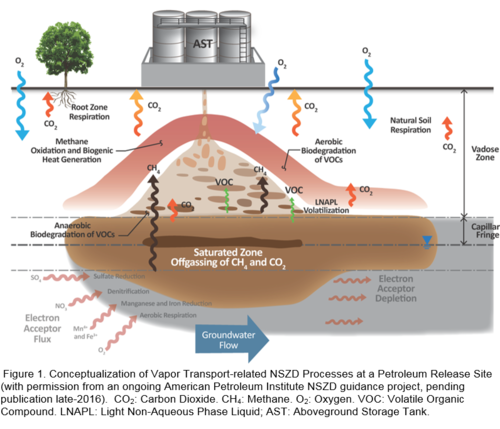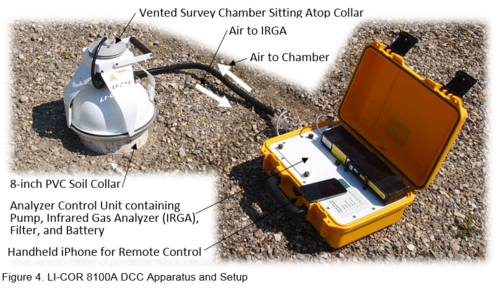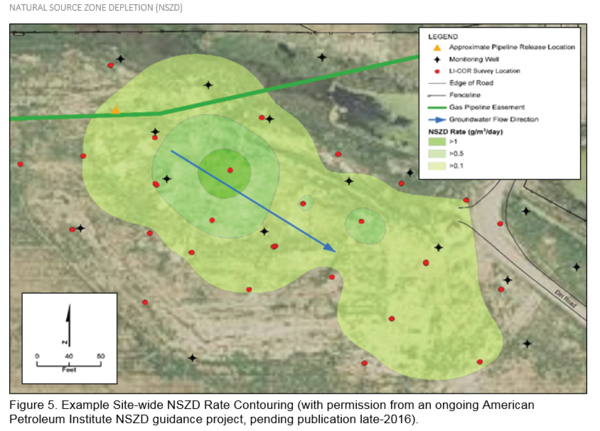User:Debra Tabron/sandbox
Natural source zone depletion (NSZD) is a term used to describe the collective, naturally occurring processes of dissolution, volatilization, and biodegradation that result in mass losses of light non-aqueous phase liquid (LNAPL) petroleum hydrocarbon constituents from the subsurface. NSZD is coming to the forefront of decision making at petroleum hydrocarbon remediation sites because much higher source attenuation rates are now being measured compared to previous rates based on incomplete conceptual models[1][2][3]. NSZD processes occur at most petroleum release sites and quantifying NSZD rates is an important part of an overall site remediation strategy.
Related Articles:
CONTRIBUTOR(S): Tom Palaia and Jeff Fitzgibbons
Key Resource(s):
- American Petroleum Institute (API). Pending. Quantification of Vapor Phase-Related NSZD Processes. In draft, pending publication in 2016/17.
- Evaluating Natural Source Zone Depletion at Sites with LNAPL. LNAPL-1. Washington, D.C.: Interstate Technology & Regulatory Council, LNAPLs Team.[4]
Introduction
After a release into the environment, petroleum hydrocarbon constituents in LNAPL undergo various different degradation processes including dissolution, volatilization, and biodegradation[5][6][7][8]. NSZD is a term used to describe these collective processes that result in mass losses of LNAPL petroleum hydrocarbon constituents from the subsurface. NSZD processes occur naturally within LNAPL-impacted zones in the subsurface. These processes physically degrade the LNAPL by mass transfer of chemical components to the aqueous and gaseous phases where they are biologically broken down via anaerobic and aerobic biodegradation.
Traditional methods of NSZD monitoring have focused on the aqueous phase biodegradation and groundwater transport of the solubilized LNAPL constituents that occur through various terminal electron acceptor processes. Aerobic respiration, denitrification, sulfate reduction, iron and manganese reduction, and methanogenesis each support hydrocarbon degradation as the supply of each electron acceptor (e.g., dissolved oxygen, nitrate, sulfate), oxidation-reduction state, and the microbiological conditions allow. These processes manifest themselves as changes in dissolved electron acceptor concentrations and production of soluble byproducts such as ferrous iron, dissolved methane (CH4), and carbon dioxide (CO2). Through stoichiometric conversion of the mass of electron acceptor loss and byproduct formation, the soluble or aqueous contribution to NSZD can be estimated[9][10][7]).
Understanding of the gaseous expression of NSZD processes has recently improved via emerging research[11][8][12][2]. A large advance occurred with respect to the significant amount of gases that can be produced because of anaerobic petroleum hydrocarbon biodegradation processes, predominantly methanogenesis[11]. Within the highly reduced saturated zone and overlying capillary fringe, methanogenesis occurs and generates CH4 and CO2. Because of the relatively low solubility of CH4, it is subsequently transported up to the vadose zone along with smaller amounts of CO2 and volatile organic compounds (VOCs). Within the vadose zone, LNAPL, CH4, and volatile hydrocarbons are anaerobically and aerobically biodegraded removing CH4 and O2 from the soil gas and adding CO2. We can conceptualize these vapor transport-related NSZD processes that are occurring at petroleum release sites (Fig. 1). In response to this improved understanding of NSZD, new monitoring methods have evolved to use stoichiometric conversion of the gaseous signatures left by NSZD.
In summary, NSZD processes occurring within the subsurface manifest themselves as changes to both the aqueous and gaseous phases. The NSZD rate can be best quantified by incorporating their petroleum hydrocarbon stoichiometric mass loss equivalents[4]. The methods and procedures to do this are described below.
Significance
Quantifying site-specific NSZD rates is important for various reasons. First, NSZD forms an important part of the LNAPL conceptual site model (LCSM), the written and/or illustrative representation of the physical, chemical and biological processes that control the transport, migration and actual/potential impacts of contamination. Within the LCSM, NSZD establishes a remediation baseline and supports interpretation of contaminant delineation and concentration trends. NSZD measurements can be used to:
- Refine the LCSM with quantification of LNAPL loss rates
- Delineate the LNAPL footprint using vadose zone indicators of biodegradation
- Support estimates of remedial timeframes
- Assess LNAPL stability through application of a mass balance of losses and measured mobile LNAPL flux[13]
Measured NSZD rates can also form the basis for remediation technology selection, design, and optimization. For example:
- Comparing LNAPL mass removal rates from NSZD to other future potential remedial actions
- Supporting a cost/benefit analysis of future remediation by evaluating the value of additional remediation compared to NSZD
- Evaluating remedial progress via periodic NSZD measurements during static, re-equilibration periods in areas of residual hydrocarbons during an active remediation program
- Using NSZD rates as an endpoint for active remediation
Throughout the remediation life cycle, measured NSZD rates can be used for a variety of decision-making purposes, ranging from technology selection to system shutdown or site closure.
Measuring the NSZD Aqueous Expression
NSZD is quantified by summing the petroleum hydrocarbon stoichiometric equivalent of biodegradation that expresses itself by changes in both the aqueous (soluble) and gaseous (vapor) phases[4]. This section covers the aqueous component. Within the saturated zone, aerobic respiration, denitrification, sulfate reduction, iron and manganese reduction, and methanogenesis each support hydrocarbon degradation and LNAPL mass loss. For example, nitrate, iron, sulfate, and manganese reduction are some of the representative reactions for each process (Table 1). These processes manifest themselves as decreases in dissolved electron acceptor concentrations and production of soluble byproducts such as ferrous iron and dissolved CH4 and carbon dioxide (CO2). The soluble or aqueous contribution to NSZD can be estimated through stoichiometric conversion of the mass of electron acceptor loss and byproduct formation[9][7]). Because these estimates can be made using conventional groundwater sampling and analytical methods, the saturated zone component of NSZD is relatively well understood and well-established procedures have been in place for over 20 years to monitor the NSZD process.

The aqueous contribution to NSZD, historically known as the microbiological natural attenuation rate or assimilative capacity, is typically calculated using a mass budgeting approach[7]. The mass budgeting approach estimates dissolved hydrocarbon constituent losses within the saturated zone based on changes in the aforementioned electron acceptors and byproducts across transects through the hydrocarbon plume that spans upgradient and downgradient areas. Changes in concentrations for each process are stoichiometrically converted to hydrocarbon losses using the coefficients in Table 1. Groundwater models such as BIOSCREEN combine this mass budgeting approach with an advection dispersion model[10].
Measuring the NSZD Gaseous Expression
Current NSZD practice is to evaluate the petroleum hydrocarbon stoichiometric equivalent of biodegradation in both the aqueous phase and gaseous (vapor) phase[4]. This section covers the gaseous component.
At one site, the gaseous expression of NSZD has been shown to account for >70% of the hydrocarbon biodegradation that occurs in the subsurface[14]; [15]. Three methods to monitor the vapor transport-related portion of NSZD are currently available and widely used. These are the gradient, passive flux trap, and dynamic closed chamber (DCC) methods elaborated on below. Method choice for a particular project is a site-specific judgment based on data quality, objectives, and site conditions.
New NSZD monitoring methods continue to emerge, including an approach that uses thermal gradients [16][17]. Due to their limited applications, however, these emerging methods are not discussed herein.
Gradient Method
The gradient method uses oxygen or CO2 concentration profiles in soil gas and select soil properties (e.g., effective soil gas diffusion coefficients) to estimate the flux of gases through the vadose zone using Fick’s First Law. The change in concentration of these gases with depth within un-impacted soil above the petroleum hydrocarbons is used as a basis for estimating the flux using Equation 1.
(EQUATION 1 HERE)
Where fraction here is the effective diffusion coefficient of the gas of interest in the vadose zone soils and fraction here is the vertical concentration gradient of the gas being used to estimate NSZD rates. The gas flux is then stoichiometrically converted to an NSZD rate. The gradient method was the first published method to estimate NSZD[8].
A typical gradient method NSZD monitoring setup primarily includes a nested set of soil vapor probes installed above the LNAPL-impacted soils (Fig. 2). Soil gas samples are collected from the probes using industry-standard procedures and analyzed using a field landfill gas meter (e.g., LANDTEC GEM 2000). The data can then be analyzed using existing software such as Microsoft Excel.
Passive Flux Trap
A passive flux trap is a flow-through, static chamber fitted with a chemical trap that has historically been used to measure soil-surface CO2 efflux[18]. The passive flux trap method was recently adapted for NSZD monitoring[2] and subsequently commercialized and further refined by E-Flux, LLC in Fort Collins, Colorado. The E-Flux CO2 trap employs the use of a dual-sorbent design to collect CO2 leaving the subsurface (Fig. 3). The traps are installed in the shallow ground surface (i.e., 1–3 inches deep) and left in place for a 1–2 week timeframe. Over this time, CO2 derived from LNAPL degradation (i.e., fossil fuel-derived CO2) migrating upward from the subsurface to the atmosphere is collected inside the receiver pipe by a bottom caustic sorbent element. An upper sorbent element captures atmospheric CO2 (i.e., modern CO2) to avoid cross-contamination of the lower sorbent element, which is solely used for the NSZD estimate. The trap is deployed for a period of time that does not allow for either the top or bottom elements to become saturated with CO2. After the deployment period, the trap is retrieved and shipped to a laboratory for analysis of CO2. The CO2 efflux is estimated by dividing the trip blank-corrected mass of CO2 sorbed on the lower element by the deployment duration and the cross sectional area of the received pipe.
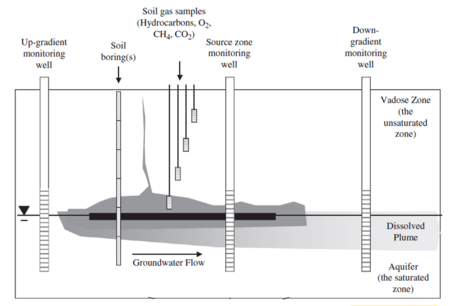
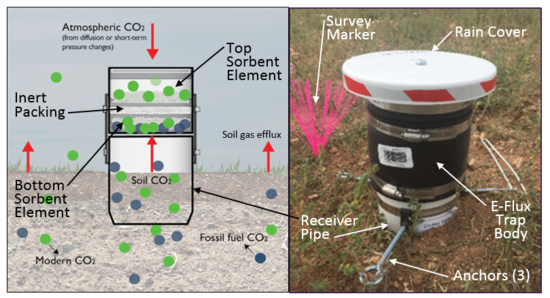
Dynamic Closed Chamber (DCC) Method
A DCC system is an active, specially adapted, direct measurement approach to estimate soil gas efflux at the ground surface. It pumps a small, closed loop circulation of air between a chamber set on a soil collar shallowly embedded in the ground surface and an external non-destructive gas analyzer that monitors the increase in CO2 concentration. To minimize errors associated with pressure differential inside and outside of the chamber, it is fitted with an engineered vent. DCC has been demonstrated to be a consistent efflux measurement method and used as reference for comparison to others[19]. The DCC has been used primarily for ecological carbon monitoring purposes and was recently was adapted for NSZD monitoring[12]. Figure 4 shows an example DCC system, the LI-COR® 8100A automated soil flux system (LI-COR® BioSciences, Inc., Lincoln, Nebraska), and its typical setup for NSZD monitoring.
Using an internal pump, the DCC system circulates vapor that has accumulated within the chamber through a closed loop. Through continuous circulation and in-line measurement of the CO2 concentration by the non-destructive IRGA, the temporal increase in CO2 is recorded. The CO2 efflux is estimated using a curve fitting routine on the time series CO2 concentration data and dividing the results by the cross sectional area of the soil collar. The DCC collects rapid CO2 efflux measurements over a period of approximately 2 minutes. A series of multiple measurements are typically recorded during each field event. A long-term DCC system is also commercially available for automated repeated measurement programs[20][21]).
Gaseous Flux Background Correction
The gaseous expression of NSZD is complicated by concurrent, non-petroleum related processes that also consume O2 and create CO2[22]. These “background” processes include contributions from plant roots and microbes present in surficial and deeper soils containing natural organic matter. Therefore, correction is needed to subtract these effects prior to using the data from the gradient method and the two CO2 efflux methods (i.e., trap and DCC) for NSZD estimates. Options to eliminate the gaseous contributions of non-petroleum related sources include:
- Install measurement locations in a nearby uncontaminated setting with similar surface and subsurface conditions. Calculation of NSZD rates using this approach involves subtracting the gaseous flux measured at the background location from the total flux at each survey location atop the LNAPL footprint.
- Use radiocarbon-14 (14C) analysis on the CO2 collected from either the soil gas probes (gradient method) or the passive flux traps. The use of 14C provides an alternative, more accurate means to isolate the NSZD-derived CO2 efflux without the need to monitor outside areas. Background correction using 14C is detailed in Sihota and Mayer (2012)[23] and McCoy et al. (2014)[2].
Converting Gaseous Flux to an NSZD Rate
After elimination of gaseous effects due to non-petroleum processes, the corrected flux results can then be used to estimate a NSZD rate. A NSZD rate is typically expressed as a hydrocarbon degradation rate per unit area in a unit such as grams per square meter per day (g/m2/d). Using O2 or CO2 flux input, the NSZD rate is calculated by multiplying the background corrected gas flux, typically expressed as micromoles per square meter per second (mol/m2/s), by the molar ratio of hydrocarbon degraded in a representative mineralization reaction as shown for octane on Equation 2;
(EQUATION 2 HERE)
Stoichiometry is used to determine a mass-based NSZD rate from gaseous flux data. The mass-based unit can be converted to a volume-based unit, for example gallons per acre per year (gal/acre/yr), using the density of the predominant hydrocarbon at the site.
If enough representative measurements are made across the lateral extent of the LNAPL footprint, then a site-wide estimate of NSZD can be made. Stated simply, a site-wide NSZD rate (in units of mass per time) can be estimated by multiplying a unit area NSZD rate by an estimated lateral area of the LNAPL source zone. If unit area NSZD rates have been estimated at multiple locations, each can be apportioned to a representative area and totaled to arrive at a site-wide value. Figure 5 shows an example of mapping of NSZD rates from multiple DCC measurements at a site from which the site-wide NSZD rate was estimated to be 500 gallons per year (gal/yr).
Limitations and Challenges
NSZD is occurring at most petroleum release sites, however, site-specific conditions will drive the magnitude of rates. For example, the presence of a “typical” gaseous expression of NSZD (Fig. 1) is contingent upon the presence of LNAPL and free exchange of atmospheric oxygen with the subsurface. If the site contains predominantly impervious ground cover, then NSZD processes will deviate from that described herein and procedures to measure it must be adapted accordingly. Many other site conditions such as low permeability soil layers, perching water or wet vadose zones, shallow water tables, and cold climates can also affect NSZD processes that must also be taken into account during the design of any NSZD monitoring plan.
NSZD rates measured using the methods described above quantify total hydrocarbon mass loss and do not speciate loss or degradation rates of individual chemicals such as benzene or naphthalene from soil or LNAPL phases. Therefore, the use of NSZD data for assessment of remedial timeframe, if based on time to achieve cleanup criteria in groundwater for example, is limited. Current research is focused on correlating NSZD rates to better established remediation metrics such as LNAPL transmissivity and chemical-specific degradation rates. For example, Ng et al. (2016) developed a mass balance model that provides some insights on the contributions of various hydrocarbon constituent classes to the overall NSZD rate at a crude oil research site.
Lastly, NSZD rates are variable. They can fluctuate daily with day/night and changes in weather conditions, seasonally in temperate and cold climates, and anthropogenically with surrounding land use. Additionally, each method has its own unique procedure and inherent assumptions, which make its measurement results difficult to compare with others.
Due to these limitations and challenges, NSZD monitoring must be performed with a firm understanding of the data objectives and use and a sound LCSM.
Summary
NSZD is an important process that is occurring at most petroleum release sites. Measuring the rate of NSZD can be very helpful in implementing an effective remediation strategy at these sites. Several approaches to measuring and quantifying NSZD rates are now available. However, as with most environmental remediation techniques, it is equally important to be cognizant of and account for the limitations and challenges with the approach and its associated measurements.
References
- ^ Lundegard, P.D. and Johnson, P.C., 2006. Source zone natural attenuation at petroleum hydrocarbon spill sites-II: application to a former oil field. Groundwater Monitoring & Remediation, 26(4), pp.93-106.doi:10.1111/j.1745-6592.2006.00115.x
- ^ 2.0 2.1 2.2 2.3 McCoy, K., Zimbron, J., Sale, T. and Lyverse, M., 2015. Measurement of natural losses of LNAPL using CO2 traps. Groundwater, 53(4), pp.658-667. doi: 10.1111/gwat.12240
- ^ Palaia, T. 2016. Natural Source Zone Depletion Rate Assessment. Applied NAPL Science Review (ANSR), Volume 6, Issue 1, May
- ^ 4.0 4.1 4.2 4.3 Interstate Technology & Regulatory Council (ITRC). 2009. Evaluating Natural Source Zone Depletion at Sites with LNAPL. LNAPL-1. Washington, D.C.: Interstate Technology & Regulatory Council, LNAPLs Team. Report pdf
- ^ Kostecki, P.T. and E.J. Calabrese. 1989. Petroleum Contaminated Soils, Volumes 1 through 3. Lewis Publishers, Inc., Chelsea, MI.
- ^ National Research Council (NRC). 1993. In Situ Bioremediation - When Does It Work? Committee on In Situ Bioremediation, Water Science and Technology Board, Commission on Engineering and Technical Systems, National Academy Press, Washington D.C. doi: 10.17226/2131
- ^ 7.0 7.1 7.2 7.3 National Research Council (NRC). 2000. Natural Attenuation for Groundwater Remediation. Washington, DC: The National Academies Press. doi: 10.17226/9792
- ^ 8.0 8.1 8.2 8.3 8.4 Johnson, P., Lundegard, P. and Liu, Z., 2006. Source Zone Natural Attenuation at Petroleum Hydrocarbon Spill Sites-I: Site‐Specific Assessment Approach. Groundwater Monitoring & Remediation, 26(4), pp.82-92.doi: 10.1111/j.1745-6592.2006.00114.x
- ^ 9.0 9.1 Wiedemeier, T.H., Wilson, J.T., Kampbell, D.H., Miller, R.N. and Hansen, J.E., 1995. Technical Protocol for Implementing Intrinsic Remediation with Long-Term Monitoring for Natural Attenuation of Fuel Contamination Dissolved in Groundwater. U.S. Air Force Center for Environmental Excellence, Technology Transfer Division, Brooks Air Force Base, San Antonio, Texas.]
- ^ 10.0 10.1 Newell, C.J., Gonzales, J., and McLeod, R., 1996. BIOSCREEN natural attenuation decision support system, U.S. Environmental Protection Agency. EPA/600/R-96/087. Report pdf
- ^ 11.0 11.1 Amos, R.T., Mayer, K.U., Bekins, B.A., Delin, G.N. and Williams, R.L., 2005. Use of dissolved and vapor‐phase gases to investigate methanogenic degradation of petroleum hydrocarbon contamination in the subsurface. Water Resources Research, 41(2). doi: 10.1029/2004WR003433
- ^ 12.0 12.1 Sihota, N.J., Singurindy, O. and Mayer, K.U., 2010. CO2-efflux measurements for evaluating source zone natural attenuation rates in a petroleum hydrocarbon contaminated aquifer. Environmental Science & Technology, 45(2), pp.482-488. doi: 10.1021/es1032585
- ^ Mahler, N., Sale, T. and Lyverse, M., 2012. A mass balance approach to resolving LNAPL stability. Groundwater, 50(6), pp.861-871.doi: 10.1111/j.1745-6584.2012.00949.x
- ^ Molins, S., Mayer, K.U., Amos, R.T. and Bekins, B.A., 2010. Vadose zone attenuation of organic compounds at a crude oil spill site - Interactions between biogeochemical reactions and multicomponent gas transport. Journal of Contaminant Hydrology, 112(1), pp.15-29. doi: 10.1016/j.jconhyd.2009.09.002
- ^ Crystal Ng, G.H., Bekins, B.A., Cozzarelli, I.M., Baedecker, M.J., Bennett, P.C., Amos, R.T. and Herkelrath, W.N., 2015. Reactive transport modeling of geochemical controls on secondary water quality impacts at a crude oil spill site near Bemidji, MN. Water Resources Research. doi:10.1002/2015WR016964
- ^ Sweeney, R.E. and Ririe, G.T., 2014. Temperature as a tool to evaluate aerobic biodegradation in hydrocarbon contaminated soil. Groundwater Monitoring & Remediation, 34(3), pp.41-50. doi:10.1111/gwmr.12064
- ^ Warren, E. and Bekins, B.A., 2015. Relating subsurface temperature changes to microbial activity at a crude oil-contaminated site. Journal of Contaminant Hydrology, 182, pp.183-193. doi:10.1016/j.jconhyd.2015.09.007
- ^ Humfeld, H. 1930. A Method for Measuring Carbon Dioxide Evolution from Soil. Soil Science, Vol. 30(1), pp: 1-12.
- ^ Norman, J.M., Kucharik, C.J., Gower, S.T., Baldocchi, D.D., Crill, P.M., Rayment, M., Savage, K. and Strieglfi, R.G., 1997. A comparison of six methods for measuring soil-surface carbon dioxide fluxes. Journal of Geophysical Research, 102(D24), pp.28-771. doi: 10.1029/97JD01440
- ^ Sihota, N.J., Trost, J.J., Bekins, B.A., Berg, A., Delin, G.N., Mason, B., Warren, E. and Mayer, K.U., 2016. Seasonal Variability in Vadose Zone Biodegradation at a Crude Oil Pipeline Rupture Site. Vadose Zone Journal,15(5). doi:10.2136/vzj2015.09.0125
- ^ LI-COR Chambers. 2016. Accessed by https://www.licor.com/env/products/soil_flux/chambers.html. October 2016.Report pdf
- ^ Rochette, P. and Hutchinson, G.L., 2005. Measurement of soil respiration in situ: chamber techniques. Publications from USDA-ARS / UNL Faculty. Paper 1379 Report pdf
- ^ Sihota, N.J. and Mayer, K.U., 2012. Characterizing vadose zone hydrocarbon biodegradation using carbon dioxide effluxes, isotopes, and reactive transport modeling. Vadose Zone Journal, 11(4). doi:10.2136/vzj2011.0204
